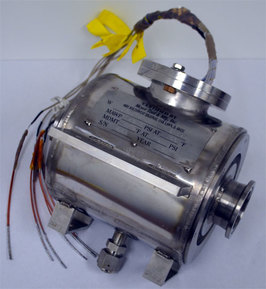Call: 708-425-9080
Repair of ASME Code Stamped Pressure Vessels
 Pressure Vessel Repair
Pressure Vessel Repair
During the service life of an ASME Code Stamped Pressure Vessel, instances can arise when repairs are needed. Repairs on ASME Code Stamped Pressure Vessels are covered by a different code than the manufacture of the ASME Code Stamped Pressure Vessel. When an ASME Code Stamped Pressure Vessel is built, it is built following the ASME Boiler and Pressure Vessel Code. Repairs, however, are covered by the National Board Inspection Code, commonly referred to as the NBIC.
The NBIC consists of three parts; Part 1 Installation, Part 2 Inspection, and Part 3 Repairs and Alterations. For this article, we will be focusing on Part 3 Repairs and Alterations. The first step in the repair of the ASME Code Stamped Pressure Vessel is determining if the repair falls under the requirements of the NBIC. Things such as changing a low water cutoff or a pressure switch would not fall under the NBIC. Section 3.3.3 of the NBIC provides examples of repairs that do fall under the NBIC. These repairs include, but are not limited to; weld repairs, weld buildup of corroded areas, installation or replacement of nozzles, attachment of parts such as studs for insulation, and mounting clips for ladders to pressure parts. It’s important to note that attachment of non-pressure bearing parts to pressure boundary components constitutes a repair.
The second major step in the repair of ASME Code Stamped Pressure Vessel is to locate a shop which can perform the work to the requirements of the NBIC. The shop must have a Certificate of Authorization to use the “R” symbol, as opposed to the Certificate of Authorization to apply the “NB” mark used when the pressure vessel was fabricated.
While these two codes may seem similar, there are key differences, including testing and documentation. During fabrication, pressure vessels are commonly tested at a pressure 1.3 times the pressure rating, however, the NBIC specifies the pressure shall be the minimum required to verify the integrity of the repair, but without exceeding 150% of the maximum working pressure of the vessel. Subtle differences in documentation also exist. When the SME Pressure Vessel is built, a U1 or U1A form is submitted to the National Board of Boiler and Pressure Vessel Inspectors. For a repair, the NBIC does not require submittal of the R1 form to the Board. A third subtle difference is in the requirements of the repair nameplate. While the original name plate attached to the vessel lists the year of manufacture, the repair name plate must include the full date of the repair, including the month, day and year.
At Meyer Tool, we are certified to both fabricate ASME Code Stamped Pressure Vessels and to repair Pressure Vessels and apply the “R” SYMBOL. Our experience in fabricating and repairing pressure vessels enables us to not only meet customer needs for new pressure vessels, but to effectively execute repairs of existing pressure vessels as well. This is another way we are able to Reduce Project Risk and help customers like you achieve the lowest total cost of ownership.
The NBIC consists of three parts; Part 1 Installation, Part 2 Inspection, and Part 3 Repairs and Alterations. For this article, we will be focusing on Part 3 Repairs and Alterations. The first step in the repair of the ASME Code Stamped Pressure Vessel is determining if the repair falls under the requirements of the NBIC. Things such as changing a low water cutoff or a pressure switch would not fall under the NBIC. Section 3.3.3 of the NBIC provides examples of repairs that do fall under the NBIC. These repairs include, but are not limited to; weld repairs, weld buildup of corroded areas, installation or replacement of nozzles, attachment of parts such as studs for insulation, and mounting clips for ladders to pressure parts. It’s important to note that attachment of non-pressure bearing parts to pressure boundary components constitutes a repair.
The second major step in the repair of ASME Code Stamped Pressure Vessel is to locate a shop which can perform the work to the requirements of the NBIC. The shop must have a Certificate of Authorization to use the “R” symbol, as opposed to the Certificate of Authorization to apply the “NB” mark used when the pressure vessel was fabricated.
While these two codes may seem similar, there are key differences, including testing and documentation. During fabrication, pressure vessels are commonly tested at a pressure 1.3 times the pressure rating, however, the NBIC specifies the pressure shall be the minimum required to verify the integrity of the repair, but without exceeding 150% of the maximum working pressure of the vessel. Subtle differences in documentation also exist. When the SME Pressure Vessel is built, a U1 or U1A form is submitted to the National Board of Boiler and Pressure Vessel Inspectors. For a repair, the NBIC does not require submittal of the R1 form to the Board. A third subtle difference is in the requirements of the repair nameplate. While the original name plate attached to the vessel lists the year of manufacture, the repair name plate must include the full date of the repair, including the month, day and year.
At Meyer Tool, we are certified to both fabricate ASME Code Stamped Pressure Vessels and to repair Pressure Vessels and apply the “R” SYMBOL. Our experience in fabricating and repairing pressure vessels enables us to not only meet customer needs for new pressure vessels, but to effectively execute repairs of existing pressure vessels as well. This is another way we are able to Reduce Project Risk and help customers like you achieve the lowest total cost of ownership.



